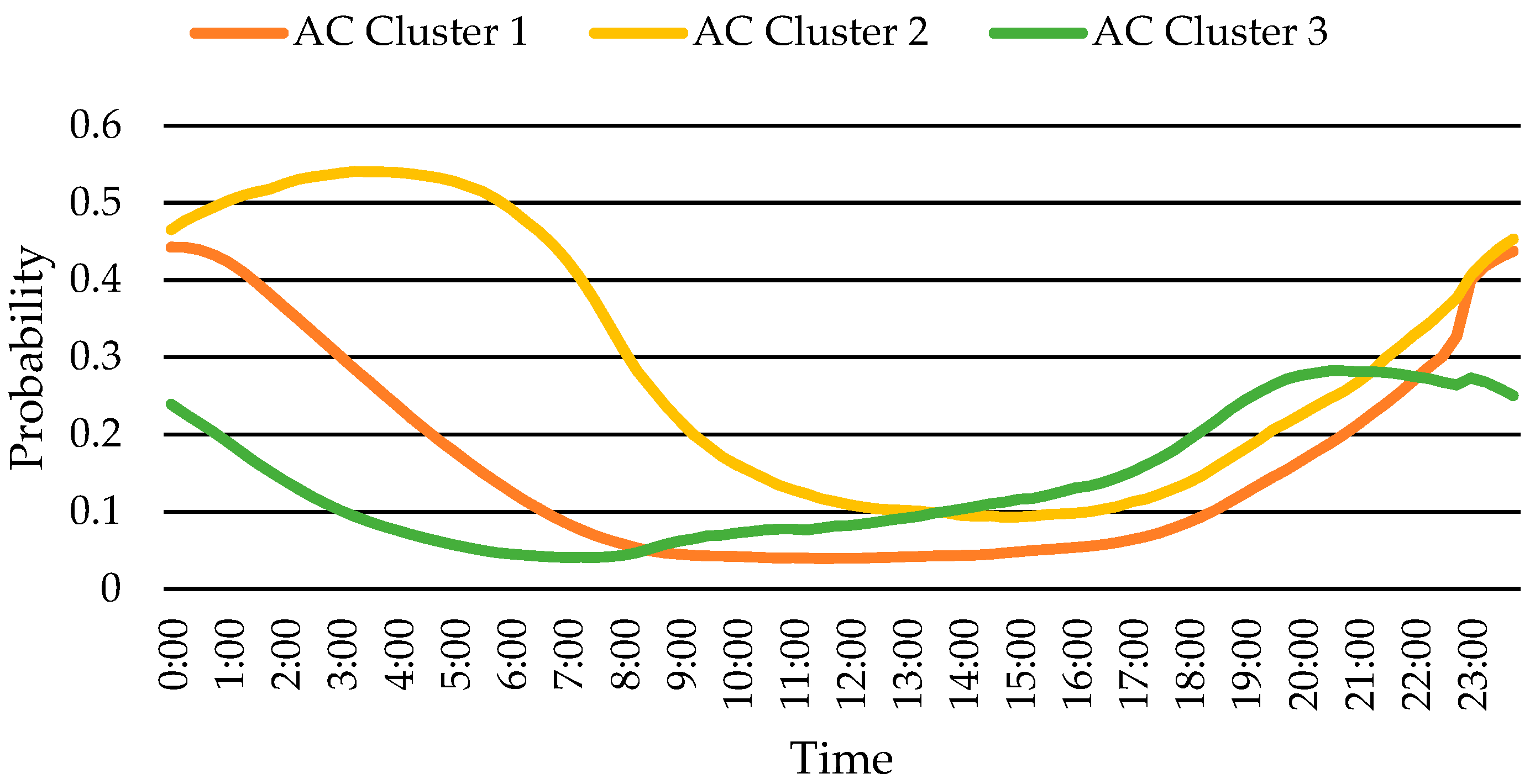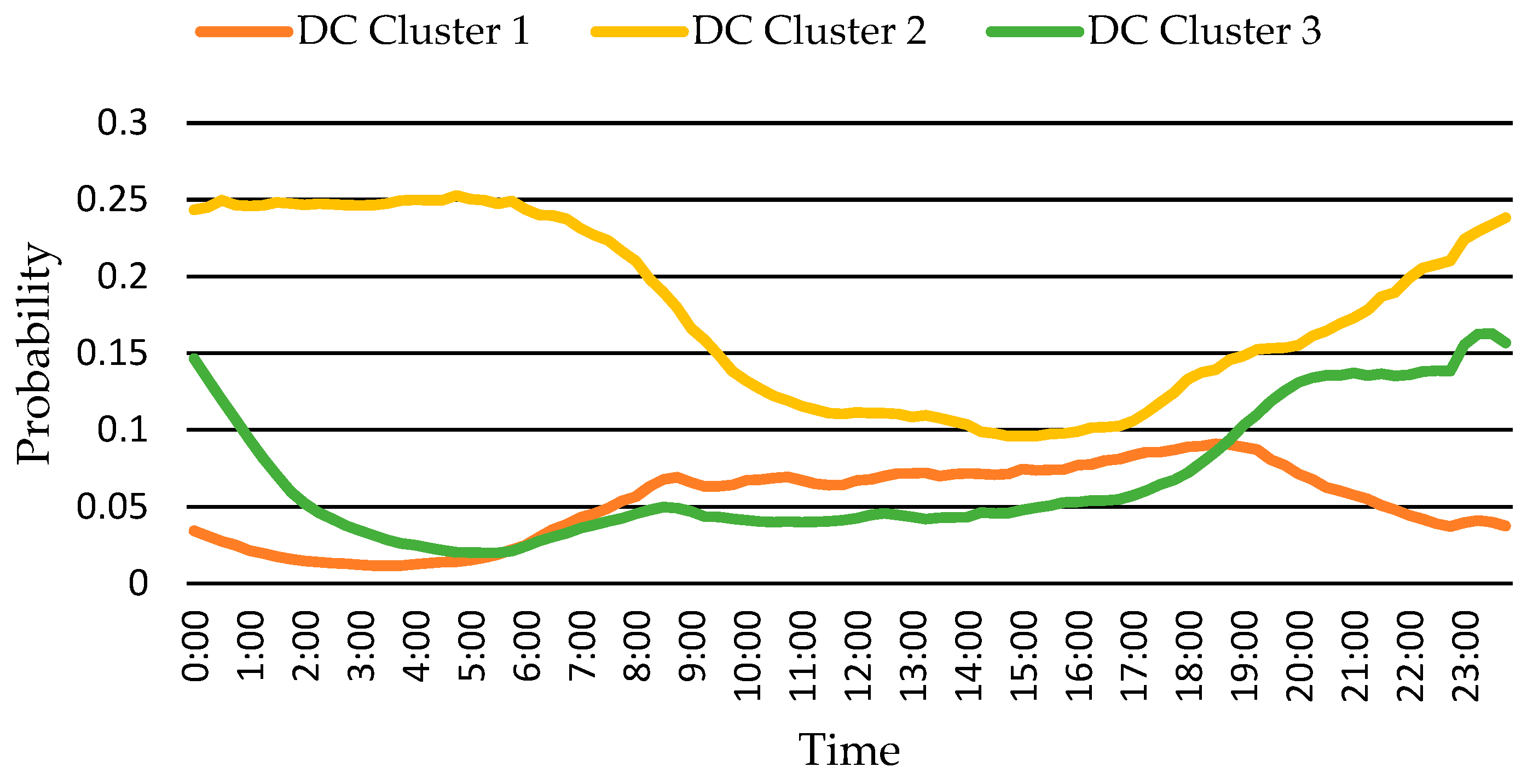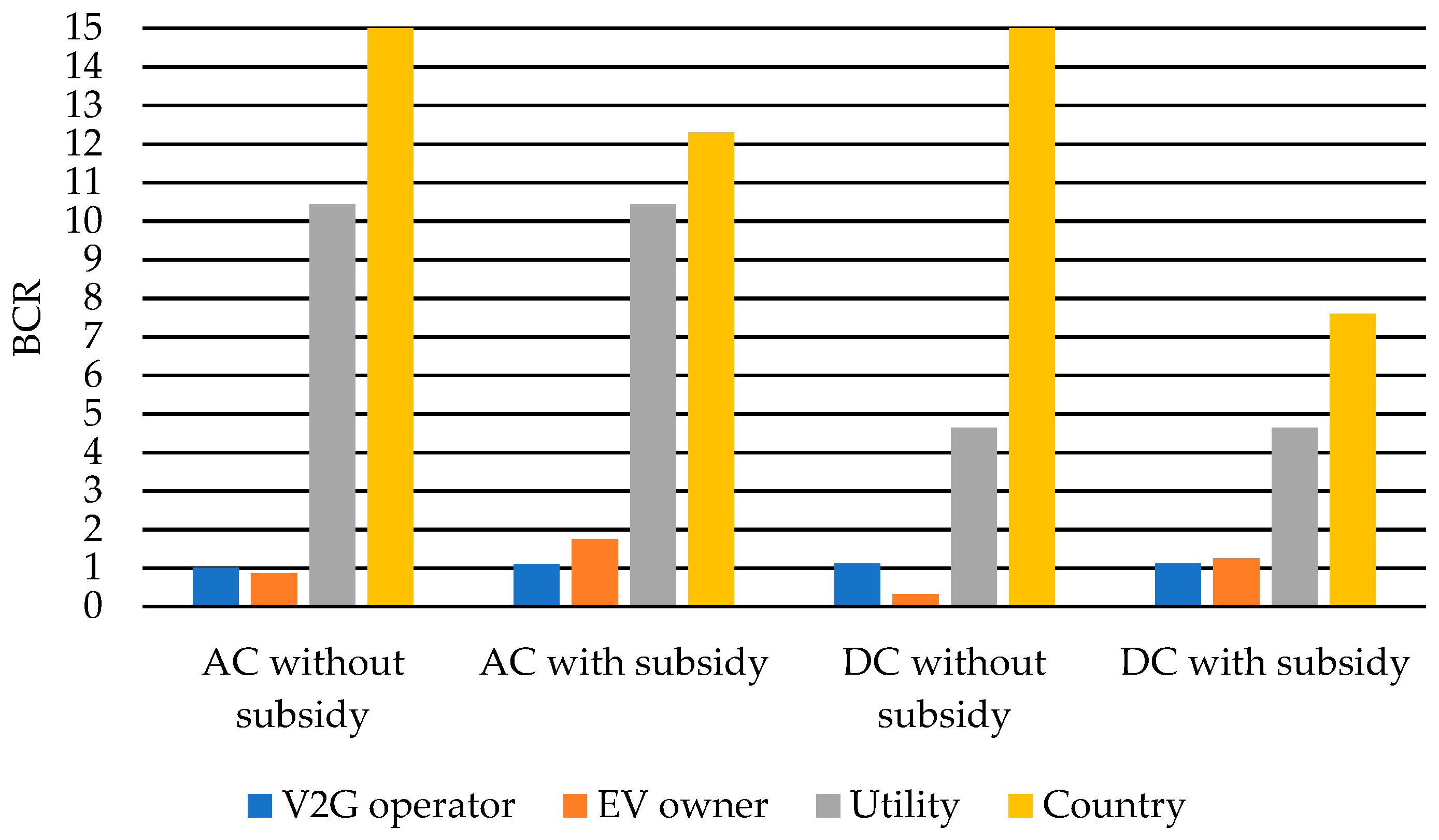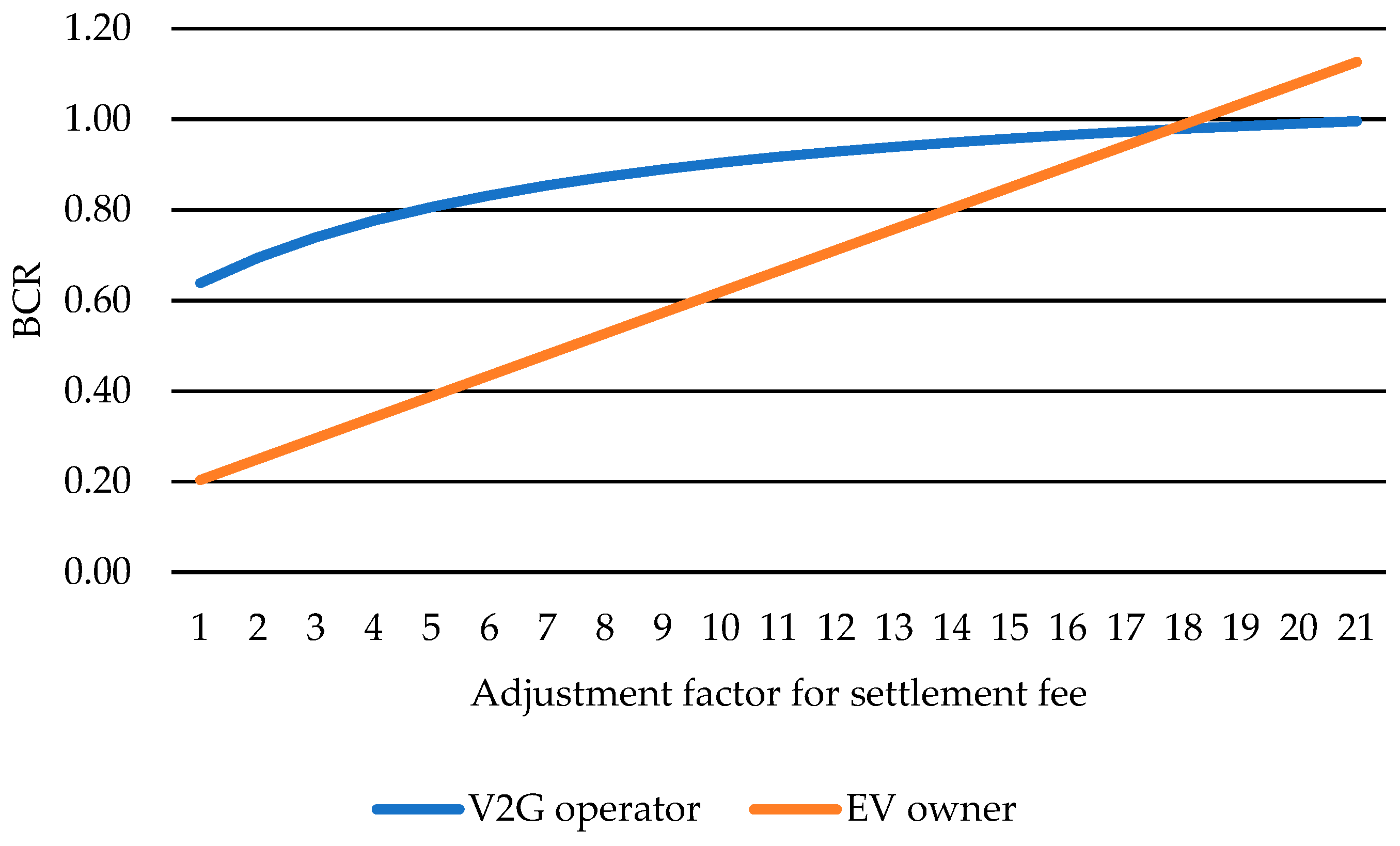Key Parameters for Economic Valuation of V2G Applied to Ancillary Service: Data-Driven Approach
Abstract
1. Introduction
2. Methodology to Estimate V2G Capacity
Available V2G Capacity of AC and DC Chargers
| Algorithm 1: EV charger segmentation model | |
| Input: Coupling state data for each charger (): ; Output: Coupling probability of group () for each time (): ; | |
| 1: | for to do |
| 2: | for to do |
| 3: | |
| 4: | end for |
| 5: | end for |
| 6: | Calculate EV charger segmentation using coupling probability () of charger () for each time by k-means clustering |
| 7: | for to do |
| 8: | |
| 9: | end for |
- i.
- EVs are considered as usable sources of charging and discharging if the EVs are connected to a charger.
- ii.
- The participation rate for the V2G program is 25%.
- iii.
- The efficiency of charging and discharging is 95%.
3. Component Modeling
3.1. V2G-Service Operator
3.2. Utility
3.3. EV Owner
3.4. Country
3.5. Benefit–Cost Ratio Calculation
4. Results and Analysis
4.1. Scenarios
4.2. Analysis
5. Conclusions
Author Contributions
Funding
Data Availability Statement
Conflicts of Interest
References
- Vaziri, S.; Rezaee, B.; Monirian, M. Utilizing renewable energy sources efficiently in hospitals using demand dispatch. Renew. Energy 2020, 151, 551–562. [Google Scholar] [CrossRef]
- Ravi, S.; Aziz, M. Utilization of electric vehicles for vehicle-to-grid services: Progress and perspectives. Energies 2021, 15, 589. [Google Scholar] [CrossRef]
- Zhu, X.; Xia, M.; Chiang, H.D. Coordinated sectional droop charging control for EV aggregator enhancing frequency stability of microgrid with high penetration of renewable energy sources. Appl. Energy 2018, 210, 936–943. [Google Scholar] [CrossRef]
- Li, C.; Cao, Y.; Kuang, Y.; Zhou, B. Influences of Electric Vehicles on Power System and Key Technologies of Vehicle-to-Grid; Springer: Berlin/Heidelberg, Germany, 2016. [Google Scholar]
- Kempton, W.; Tomic, J. Vehicle-to-grid power fundamentals: Calculating capacity and net revenue. J. Power Sources 2005, 144, 268–279. [Google Scholar] [CrossRef]
- Zhong, W.; Xie, K.; Liu, Y.; Yang, C.; Xie, S. Topology-aware vehicle-to-grid energy trading for active distribution systems. IEEE Trans. Smart Grid 2019, 10, 2137–2147. [Google Scholar] [CrossRef]
- Yoo, Y.; Al-Shawesh, Y.; Tchagang, A. Coordinated control strategy and validation of vehicle-to-grid for frequency control. Energies 2021, 14, 2530. [Google Scholar] [CrossRef]
- Arias, N.; Hashemi, S.; Andersen, P.; Traeholt, C.; Romero, R. Assessment of economic benefits for EV owners participating in the primary frequency regulation markets. Int. J. Electr. Power Energy Syst. 2020, 120, 105985. [Google Scholar] [CrossRef]
- Xu, Y.; Zhang, W.; Hug, G.; Kar, S.; Li, Z. Cooperative control of distributed energy storage systems in a microgrid. IEEE Trans. Smart Grid 2015, 6, 238–248. [Google Scholar] [CrossRef]
- Patrizi, N.; LaTouf, S.; Tsiropoulou, E.; Papavassiliou, S. Prosumer-centric self-sustained smart grid systems. IEEE Syst. J. 2022, 1–12. [Google Scholar] [CrossRef]
- Steffen, T.; Fly, A.; Mitchell, W. Optimal electric vehicle charging considering the effects of a financial incentive on battery ageing. Energies 2020, 13, 4742. [Google Scholar] [CrossRef]
- Moon, Y.; Ahn, J.; Hur, W.; Kim, W.; Shin, K. Economic valuation of vehicle-grid integration (VGI) in a demand response application from each stakeholder’s perspective. Energies 2021, 14, 761. [Google Scholar] [CrossRef]
- Guille, C.; Gross, G. A conceptual framework for the vehicle-to-grid (V2G) implementation. Energy Policy 2009, 37, 4379–4390. [Google Scholar] [CrossRef]
- Shafie-khah, M.; Heydarian-Forushani, E.; Osório, G.J.; Gil, F.A.; Aghaei, J.; Barani, M.; Catalão, J.P. Optimal behavior of electric vehicle parking lots as demand response aggregation agents. IEEE Trans. Smart Grid 2016, 7, 2654–2665. [Google Scholar] [CrossRef]
- Lin, J.; Leung, K.; Li, V. Optimal scheduling with vehicle-to-grid regulation service. IEEE Internet Things J. 2014, 1, 556–569. [Google Scholar] [CrossRef]
- Aggarwal, C.C.; Reddy, C.K. Data Clustering: Algorithms and Applications; CRC Press: Boca Raton, FL, USA, 2016; pp. 87–110. [Google Scholar]
- Ministry of Economy and Finance. Inspection and Expansion of Pollution-Free Vehicle Charging Infrastructure. Available online: https://www.moef.go.kr/synapView/previewTop.jsp?CastExtn=HWP&orignlFileNm=(21-13)%2002%20%EB%B9%853%20%EC%82%B0%EC%97%85%20%EC%A4%91%EC%A0%90%EC%B6%94%EC%A7%84%EA%B3%BC%EC%A0%9C%205%20(%EA%B3%B5%EA%B0%9C).hwp&atchFileId=ATCH_000000000018214&fileSn=3 (accessed on 1 February 2022).
- Korea Power Exchange. Rules for Korean Electricity Market. Available online: https://www.kpx.or.kr/www/selectBbsNttView.do?key=29&bbsNo=114&nttNo=21790&searchCtgry=&searchCnd=all&searchKrwd=&pageIndex=1&integrDeptCode= (accessed on 1 February 2021).
- Ministry of Environment. Information of Electric Vehicle Charging Fee. Available online: https://www.ev.or.kr/portal/chargerfee (accessed on 1 March 2022).
- Korea Power Exchange. Settlement for Ancillary Service for Operating Power System. Available online: https://new.kpx.or.kr/menu.es?mid=a10107020000 (accessed on 30 April 2021).
- Korea Electro Technology Research Institute. Demand Management Project Evaluation Report; Korea Electro Technology Research Institute: Changwon-si, Korea, 2012. [Google Scholar]
- Korea Electric Power Corporation. EV-Grid Integration(VGI) and Control Technology Development and Wide Area V2G field Demonstration for EV as a Fast-DR Resource. Unpublished work.
- Electric Power Statistics Information System. Power Generation Facility Status. Available online: http://epsis.kpx.or.kr/epsisnew/selectEkifBoardList.do?menuId=080402&boardId=040200 (accessed on 1 September 2021).
- Energy Transition Policy and Social Costs of Power Generation. Environmental and Resource Economics Review. Available online: https://journal.resourceeconomics.or.kr/articles/article/Y5dy/#Information (accessed on 1 February 2021).









| Type | Cluster Number | Proportion |
|---|---|---|
| AC Charger | AC cluster 1 | 47.8% |
| AC cluster 2 | 9.8% | |
| AC cluster 3 | 42.4% | |
| DC Charger | DC cluster 1 | 61.8% |
| DC cluster 2 | 5.2% | |
| DC cluster 3 | 33.0% |
| Year | 2020 | 2021 | 2022 | 2023 | 2024 | 2025 |
|---|---|---|---|---|---|---|
| EVs (thousands) | 137 | 239 | 462 | 685 | 907 | 1130 |
| AC chargers (thousands) | 54.3 | 143 | 232 | 321 | 410 | 500 |
| AC capacity (MW) | 14.5 | 38.3 | 62 | 82.8 | 109.5 | 133.3 |
| DC chargers (thousands) | 6.5 | 10 | 13.5 | 17 | 20.5 | 24 |
| DC Capacity (MW) | 4.95 | 7.62 | 10.29 | 12.96 | 15.62 | 18.29 |
| Stakeholders | Benefit/Cost | Sign | Factors | Description |
|---|---|---|---|---|
| V2G-service operator | Benefit | SB 1 | Settlement for primary reserve | Reward for participating in the primary reserve |
| SB 2 | Settlement for secondary reserve | =0 due to no settlement | ||
| SB 3 | Settlement for tertiary reserve | Reward for participating in the tertiary reserve | ||
| SB 4 | Price difference | Price difference between the discharging and recharging fee | ||
| SB 5 | Government subsidy | Subsidy for the initial investment for V2G | ||
| Cost | SC 1 | Payment for EV owner | 80% of (SB1 + SB2 + SB3 + SB4) | |
| SC 2 | Facilities upgrade costs | In proportion to customers participating in V2G service | ||
| SC 3 | Annual indirect cost for V2G service | 15% of (SB1 + SB2 + SB3 + SB4 − SC1) | ||
| SC 4 | Annual direct cost for V2G service | 70% of (SB1 + SB2 + SB3 + SB4 − SC1) | ||
| Utility | Benefit | UB 1 | Reduction of power purchase | As much as the capacity participating in ancillary service |
| UB 2 | Investment deferral in T&D grid reinforcement | Cost for T&D investment for V2G | ||
| Cost | UC 1 | Payment for primary reserve | (=SB1) | |
| UC 2 | Payment for secondary reserve | (=SB2) | ||
| UC 3 | Payment for tertiary reserve | (=SB3) | ||
| UC 4 | Payment for price difference | (=SB4) | ||
| UC 5 | Energy management system for V2G service | Investment for V2G service | ||
| EV owner | Benefit | EB 1 | Reward for V2G participation | (=SC1) |
| EB 2 | Government subsidy | Subsidy for the initial investment for V2G | ||
| Cost | EC 1 | Battery degradation | 30 KRW/kWh | |
| EC 2 | Vehicle control modules | Cost for the initial investment for V2G | ||
| EC 3 | Bidirectional onboard charger | Cost for the initial investment for V2G | ||
| Country | Benefit | CB 1 | Investment deferral in power generation | Investment deferral in generation |
| CB 2 | emission reduction | Due to the usage reduction of fossil fuels | ||
| CB 3 | Value-added creation | Economic value-added creation | ||
| CB 4 | Production inducement | Production inducement in adjacent industries | ||
| Cost | CC 1 | Subsidy | To V2G-service operator and EV owner |
| AC without Subsidy | AC with Subsidy | DC without Subsidy | DC with Subsidy | |
|---|---|---|---|---|
| V2G-service operator | 1.0 | 1.1 | 1.1 | 1.1 |
| EV owner | 0.8 | 1.7 | 0.3 | 1.2 |
| Utility | 10.4 | 10.4 | 4.6 | 4.6 |
| Country | undefined | 12.3 | undefined | 7.5 |
Publisher’s Note: MDPI stays neutral with regard to jurisdictional claims in published maps and institutional affiliations. |
© 2022 by the authors. Licensee MDPI, Basel, Switzerland. This article is an open access article distributed under the terms and conditions of the Creative Commons Attribution (CC BY) license (https://creativecommons.org/licenses/by/4.0/).
Share and Cite
Kim, J.; Kim, J.; Jeong, H. Key Parameters for Economic Valuation of V2G Applied to Ancillary Service: Data-Driven Approach. Energies 2022, 15, 8815. https://doi.org/10.3390/en15238815
Kim J, Kim J, Jeong H. Key Parameters for Economic Valuation of V2G Applied to Ancillary Service: Data-Driven Approach. Energies. 2022; 15(23):8815. https://doi.org/10.3390/en15238815
Chicago/Turabian StyleKim, Junhyung, Jinho Kim, and Hwanmin Jeong. 2022. "Key Parameters for Economic Valuation of V2G Applied to Ancillary Service: Data-Driven Approach" Energies 15, no. 23: 8815. https://doi.org/10.3390/en15238815
APA StyleKim, J., Kim, J., & Jeong, H. (2022). Key Parameters for Economic Valuation of V2G Applied to Ancillary Service: Data-Driven Approach. Energies, 15(23), 8815. https://doi.org/10.3390/en15238815





